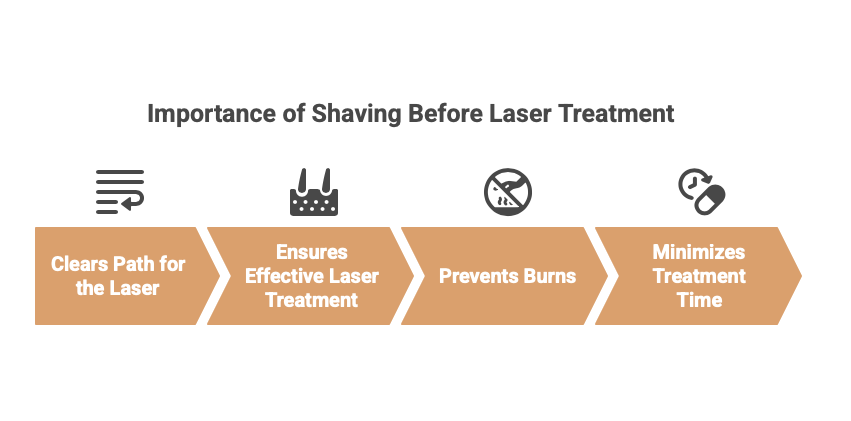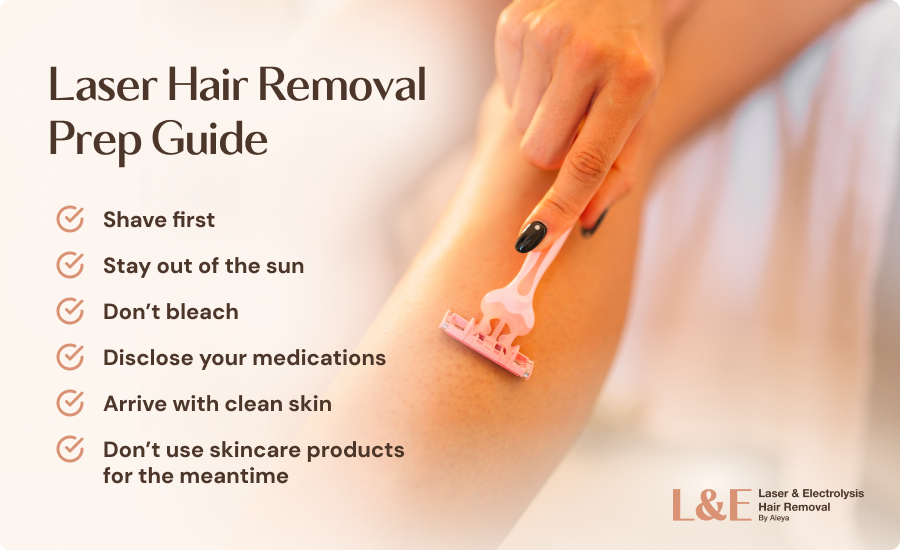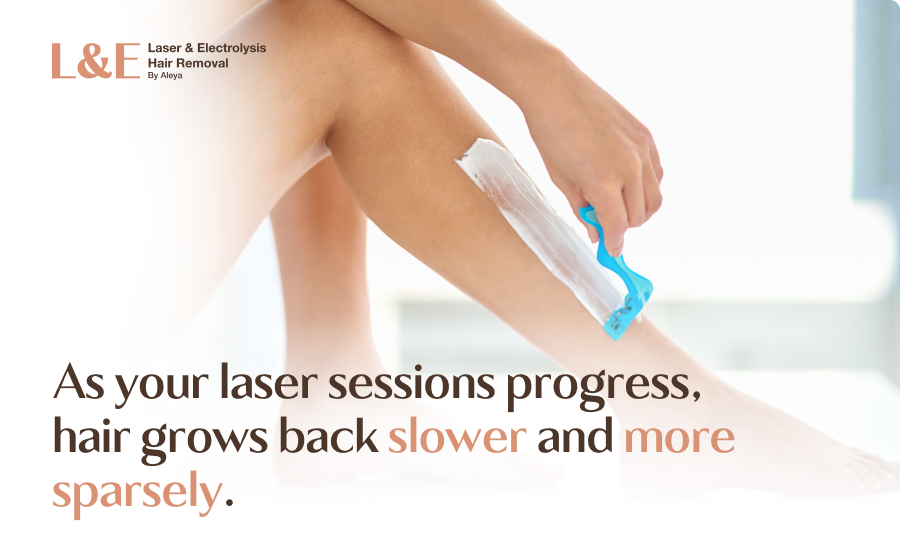Should You Shave Before Laser Hair Removal? [Tips + FAQs]
![Should You Shave Before Laser Hair Removal? [Tips + FAQs]](https://www.laserbyaleya.com/wp-content/uploads/2025/08/do-you-shave-before-laser-hair-removal-hero-image.png)
Should You Shave Before Laser Hair Removal? Key Takeaways
- Shave the treatment area one to two days before your laser hair removal appointment
- Shaving allows the laser to reach the hair follicle without getting blocked by surface hair
- If the treatment area isn’t fully shaved, your session can take a lot longer, especially on larger spots like the back or thighs
It’s important to shave before your laser hair removal session.
Removing surface hair helps the laser reach the follicle more effectively, which makes the treatment work better and lowers the chance of skin irritation or laser hair removal burns.
In fact, a recent study found that skipping key prep steps, like shaving, can significantly increase the likelihood of side effects during laser hair removal.
In this guide, we will:
- Find out the best time to shave for optimal results
- Discover how proper shaving improves safety and effectiveness
- Get expert-approved tips to prep your skin
- Share the right way to shave after treatment to protect your skin and boost results
How Soon Should You Shave Before Your Laser Appointment?
According to recent findings, shaving a day before treatment can significantly reduce the risk of irritation or side effects.
This gives your skin time to settle and ensures the laser can target the hair follicles effectively without causing irritation.
Why It’s Important To Shave Before Your Laser Appointment
Shaving before your laser session is more than just a suggestion, as it directly impacts how effective and safe your treatment will be.
Here’s why it’s so important:
- Shaving gives the laser a clear path to the hair follicle, so it can do its job effectively
- If surface hair is left behind, it can absorb the laser’s energy first, increasing the risk of burns, bumps, or irritation
- Incomplete shaving can significantly extend treatment time, especially in larger areas like the back or thighs
In short, a clean shave ensures better results, safer sessions, and smoother skin.

How To Prepare for Laser Hair Removal
Get your skin ready for the best results with these simple laser hair removal prep tips.
1. Stop Plucking and Waxing
Laser hair removal works by targeting the root of each hair, so if you’ve plucked or waxed it away, the laser has nothing to treat.
To get the best results, skip waxing, tweezing, and hair removal creams for at least four to six weeks before your appointment.
Shaving, on the other hand, is totally fine. It only removes hair at the surface, so it won’t interfere with the treatment.
2. Shave the Area
Give the treatment area a clean shave one to two days before your session.
This helps the laser reach the hair root more effectively, without getting blocked by surface hair or risking a burn.
3. Avoid Sun Exposure
Skip sunbathing for at least two weeks before your appointment.
That includes:
- Tanning in direct sunlight
- Tanning beds
- Self-tanners or bronzing products
Why? Because sun-exposed or sunburned skin is extra sensitive and more likely to react with irritation, dark spots, or even blistering during your laser session.

4. Skip the Bleach
Bleaching lightens the pigment in your hair, making it more difficult for the laser to find and destroy the follicle.
Let your natural hair color grow back in for about four to six weeks before your treatment, as this helps the laser do its job more effectively.
5. Disclose All Medications
Be sure to let your laser specialist know about any medications you’re taking.
Even if it’s a new prescription, it’s always worth mentioning so your specialist can keep your session safe and effective.
That includes antibiotics, birth control, acne treatments, or anything that might make your skin more sensitive to light.
Medications like antibiotics, retinoids, and hormonal treatments can heighten skin sensitivity, increasing the risk of:
- Redness
- Blistering
- Pigmentation issues
6. Clean the Treatment Area
On the day of your appointment, skip the lotions, oils, makeup, and deodorant so your skin is clean and laser ready.
A quick wash with mild soap and water is all you need. Any leftover products can interfere with the laser and irritate your skin.
7. Dress for Comfort
Wear something soft and breathable to your appointment, especially if you’re treating sensitive spots like the underarms, bikini line, or legs.
8. Stay Hydrated and Avoid Caffeine
Drink plenty of water a day before your appointment, as well-hydrated skin responds better to treatment and heals faster.
Then, try to avoid caffeine the day of your session, as it can make you more sensitive to the laser.
9. Know What To Expect at Your First Appointment
During your first session, your technician will review your treatment plan, answer any last-minute questions, and might mark the area to ensure precision.
They might also perform a quick patch test to check how your skin responds to the laser.
Understanding the process ahead of time can ease any nerves and help you feel confident going into your session.
10. Pause Active Skincare Products (if You’re Treating the Face)
If you’re treating your face, pause any skincare products with retinoids, glycolic acid, or salicylic acid about three to five days before your appointment.
These ingredients can make your skin more sensitive and increase the chance of irritation after your session

What To Expect After Your Laser Hair Removal Session
You’ll likely notice a visible reduction in hair growth after just one session, but keep in mind, it won’t remove all the hair right away.
Now that your session is done, here’s how your skin responds and what you might notice in the days ahead.
1. Right After Your Session
Your first laser session often brings the most significant results.
The laser energy heats the follicles, disrupting their growth by either weakening or fully disabling them.
It’s normal to see mild redness or slight swelling right after treatment, especially with traditional laser systems, as your skin responds to the heat. This typically fades within a few hours.
2. 5 to 19 Days After Your First Treatment
Around this time, you’ll start noticing changes.
Here’s what to expect:
- Shedding begins: The treated hair will start to fall out as the damaged follicles give way. This can look like patchy hair loss or thinning.
- Visible reduction: Some areas may look noticeably smoother or even hair-free.
Don’t mistake shedding for regrowth; it’s just the damaged hair being pushed out of the follicle.
Tip: Once your skin calms down, gentle exfoliation can help the process along. Just avoid harsh scrubs or acids unless cleared by your technician.
Can You Shave After Laser Hair Removal?
Yes, you can shave after laser hair removal, but when and how you do it matters.
In the first two to three days post-treatment, you might notice temporary side effects, such as:
- Red
- Sensitive
- Slightly warm
This is part of the normal healing process, and during this time, it’s best to avoid shaving.
Your skin is more delicate, and shaving too soon can lead to irritation or bumps.
Once the area feels completely calm, meaning no redness, tenderness, or sensitivity, you can safely shave any shedding or regrowth using a clean, sharp razor and gentle pressure.
How Often Should You Shave Between Sessions?
It depends on how your hair responds to treatment.
As you go through your laser hair removal sessions, you’ll likely find yourself shaving less, since the hair grows back finer, slower, and in fewer patches.
Before your next appointment, it’s best to shave one to two days in advance.
This keeps the surface clear so the laser can focus on the follicles beneath the skin.

Choose Laser by Aleya for Smooth, Hair-Free Skin
At Laser by Aleya, every treatment is customized to fit your skin tone, hair type, and personal goals.
From your very first visit, you’ll experience expert care, clear guidance, and treatments designed to deliver real, lasting results.
With thousands of satisfied clients and a reputation for both precision and compassion, Aleya uses the latest technology to make your sessions as effective and comfortable as possible.
Do You Shave Before Laser Hair Removal? FAQs
Can I wax or pluck instead of shaving?
No, you shouldn’t wax or pluck between laser hair removal sessions.
These methods remove the hair from the root, and the laser needs that root to target effectively.
Shaving is the only method that’s safe to use while you’re in treatment.
What happens if you don’t shave before laser hair removal?
If you don’t shave before your session, the laser can target the hair above the skin instead of the root, where it’s meant to work.
It makes the treatment less effective and can also lead to:
- Skin irritation or burns (from singed surface hair)
- A less comfortable experience
- Delayed results or the need for more sessions
For the best results, always shave the area one to two days in advance unless your provider gives different instructions.
What will happen if I forget to shave before my appointment?
Just let your laser specialist know.
Depending on the area and how much hair is left, they might do a quick shave for you or reschedule your session to make sure everything goes smoothly.
Does regular shaving make hair grow back thicker?
No, it doesn’t. Shaving doesn’t change your hair’s thickness, color, or how fast it grows.
It might feel coarser at first because the razor cuts the hair at a blunt angle, but the actual texture and growth stay the same.


